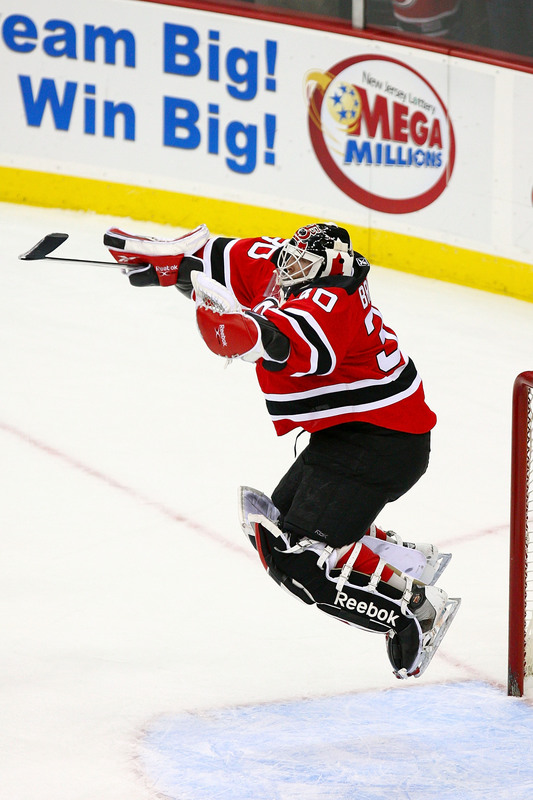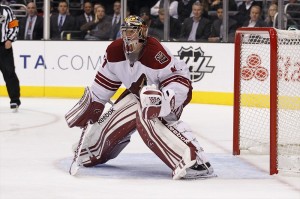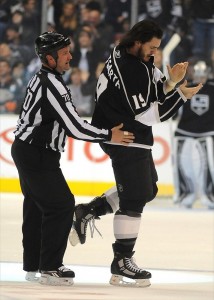
Over the last couple of decades, fantasy sports have probably evolved in ways that fantasy managers from the olden days couldn’t have imagined.
Fantasy hockey isn’t any different as various head-to-head leagues have digressed away from the original 5 x 5 format and have started to include statistics such as face-offs won, hits, shots, and game winning goals. While a number of offensive categories have been put into play in head-to-head formats over the last several years, categories for goalies have also expanded as shots saved and shots against have been incorporated in deeper fantasy leagues.
[Also: If you like Daily Hockey Fantasy be sure to check out our official partner, DraftKings.com]
Coming out on top in head-to-head formats might seem as simple as having a strong draft day, but there are a number of intangibles that fantasy managers must also account for during the course of the fantasy season if they want to be crowned champion after their respective playoffs end.
If fantasy managers in head-to-head formats hope to make a deep run in the playoffs, then there are a couple of strategies that are worth considering if one wants to have success in the regular fantasy season as well as the postseason.
Know Your League Settings
This might seem like a fairly simple rule to follow, but one should always check league settings before joining a league that they are unfamiliar with.
Participating in a head-to-head league does not mean that one automatically joins a 5 x 5 or 6 x 6 format. Many leagues will have additional statistics to play with, and these categories might not be split evenly between goalies and skaters. Knowing which categories one will be playing with can help determine which players are valued the most in one’s league and who a fantasy manager should look to select when draft day rolls around.
Going into a draft without knowing league settings can certainly set one up for disaster, so it is crucial for fantasy managers to take a few minutes to familiarize themselves with their respective settings.
Who To Draft? Decisions, Decisions
Knowing which players are valued above others in your fantasy league could provide you with an advantage on draft day, especially in leagues that have categories that favor skaters.
Categories such as face-offs won, short-handed points, powerplay points, hits, shots, game-winning goals, and blocks are some statistics that more and more leagues seem to be employing nowadays. Now, add in all of the aforementioned categories with your traditional statistics (Goals, Assists, Points, +/-), and there is room for quite some confusion if one doesn’t know the categories that they are playing with while drafting.
If your league is indeed heavy on offensive categories, then it might be useful to concentrate on drafting skaters that can fulfill many offensive categories.
Stocking up on offensive players might feel like a foreign practice to some, especially during drafts that have sporadic goalie binges, but if one plays with more offensive categories, then stocking up on premium scorers should be one’s main priority.
As a fantasy hockey draft goes on, the amount of top-end point scorers drastically decreases as the talent level inevitably gets thinner. A skater-heavy selection strategy (forwards & defensemen) will likely help a manager in a number of offensive categories, but a manager must make sure to select the best players that can fill out multiple categories (G, A, SHP, PPP) at once.
Drafting an offensive defenseman or a forward that gets a fair share of powerplay time can help a fantasy manager pick up multiple categories at one time, but employing such a strategy can potentially keep a manager in many offensive showdowns with other opponents. Even though selecting an elite goalie such as Jonathan Quick, Henrik Lundqvist, Pekka Rinne, or a plethora of other stalwart netminders could be very appealing as the offensive options in a draft start to wane, but forwards aren’t the only options if one does choose to go with an offense-heavy strategy.
Centers and wingers can certainly put up tremendous offensive numbers, but finding a puck-moving defenseman that can hold his own on a top power-play unit could provide a manager with a player that helps out in categories such as power-play points and assists.
Players that register high offensive totals will always be at a premium, but that does not mean that one has to solely stick to drafting forwards. As the early rounds of your fantasy draft pass by, toggling between forwards and defensemen might be a better strategy for a fantasy manager as more and more players are taken off the board.
Goalies Are Not Irrelevant
Goalies might not be irrelevant, but they are not as important as some fantasy managers may believe them to be.
Of course, drafting a stellar goalie will undoubtedly help a fantasy manager compete in the many goaltending statistics that their

league has to offer, but there are ways to keep your fantasy hockey team in the goaltending mix without spending priority picks on top-rated netminders.
The first goalies to be selected on draft day are usually those that finished off the previous season with Vezina considerations. This year, goalies such as Mike Smith might have seen an increase in draft stock because of his performance with the Coyotes during the 2011-2012 regular season and playoffs. However, spending a high pick on any goalie might not be worth it for some fantasy managers, especially if offensive categories outweigh the amount of goalie stats that a league plays with.
Yes, there are only 30 NHL teams, which means that there will only be 30 starting goalies that will man the crease for their respective team. While the cream of the crop goalies will likely be selected in the early rounds, managers could find a formidable starting goalie in the middle rounds of a draft. Even though a middle-round goalie might not put up Henrik Lundqvist-type numbers, a fantasy manager will have a goalie that could keep him afloat during the week in their respective goalie categories.
Many fantasy leagues usually have low weekly requirements for minimum goalie starts, so it might not hurt to fill out your minimum starts per week. Sure, getting two or three appearances from a starting goalie might not help one win categories such as shots against or wins, but it could surely help one keep their losses to a minimum and their Save Percentage and GAA at a very formidable clip, even if their goalie doesn’t stand on his head and save every shot thrown his way.
On the other hand, fantasy managers that alternate two or three starting goalies on a daily basis open themselves up for more error. Managers that have a number of goalies in their starting rotation will undoubtedly lose categories such as Goals Against and are at a bigger disadvantage in the losses category. By starting a couple of goalies every day, one has a higher chance of taking a hit in categories such as Save Percentage and GAA.
Nobody is saying that starting one goalie all week is a definite solution for easy success, but it could certainly have its advantages. By spending less stock on a goalie, one could pick up more effective offensive players while netminders are being rapidly taken off of the board. Even if a fantasy manager only has one of two goalie slots filled by the end of a fantasy draft, there is still little reason to panic.
NHL teams regularly go through goaltending changes as injuries and inconsistency could oftentimes open the door for a young goalie to take the reigns to a team’s crease. Backup goalies are also particularly valuable if one already has a starting goalie selected as a backup can potentially receive one start a week (maybe against a favorable opponent) and help a manager fulfill their minimum starting requirements.
While putting less stock into goalies might not be the best idea in deep leagues that draft with almost the maximum amount of allotted teams and position slots, those in leagues shallower leagues can definitely benefit from such a strategy if employed correctly.
Dual-Position Eligibility in Fantasy Hockey

Dual-Position players speak for themselves, and most fantasy managers probably know their benefits, but it is still useful to think about how a certain type of dual-position player can help out a fantasy manager.
Oftentimes, managers will encounter players that are eligible at two positions such as C/RW, C/LW, LW/RW, and even D/RW. Having players that qualify at two positions can help a manager maximize their potential in some stat categories as well as possibly allowing an available bench player to be inserted into the lineup.
For example, leagues that play with stat categories such as face-offs won have a bit more emphasis on the center position, and a manager could maximize the amount of face-offs that their squad wins if they place a C/W in one of their wing slots. Such a strategy might bring minimal results, but fantasy sports are all about gaining whatever edge one can get over their opponent.
Having a player that is eligible for multiple positions not only gives a manager an opportunity to potentially have more production in a certain statistical category, but it gives a manager some flexibility with his weekly lineup, something that could be useful for someone looking to maximize their offensive categories.
Always Keep Tabs On Your Opponent
A lot of emphasis has always been placed on monitoring your own team, whether it be starting your players on a daily basis or making the occasional transaction through the free agency pool.
Despite the fact that keeping track of your own team is essential to survival in any fantasy format, studying your opponent might not be a bad idea either.
Checking your match-up with your opponent in a head-to-head league is something that should be done every day since it will be easy to see where you and your opponent are excelling and lagging. If by the middle of the week a fantasy manager sees that he is burying his opponent in a certain statistical category, then it might be worthwhile to bench a specific player who is providing you with an excess amount of unneeded stats for one that can help you catch your opponent in another potentially close category.
Keeping tabs on your opponent might not seem like a big deal, but it could serve as a potential scouting report for future match-ups. If you know the strengths and weaknesses of your opponent, then you might be able to better prepare yourself if you happen to meet this manager at multiple points of the fantasy season.
Careful Waiver Wire Activity
Over the years, more and more fantasy hockey leagues (and fantasy leagues in general), have been putting a cap on the amount of

players that a manager can add or drop over the course of a season.
If your league employs a maximum transaction cap, then it is of the utmost importance to keep track of which players should be worthy of a pickup. The days of adding and dropping like a madman might not be completely over, but every fantasy manager should check how their league operates in terms of maximum transactions.
Adding a streaking player might seem like a very enticing notion, especially if a fantasy manager has a player that isn’t panning out for them in the early going, but impulsive additions should be kept to a minimum as patience can really pay off in the long run. The potential addition of superstar players or bona fide scorers goes without say, but adding unproven players that look appealing because of their hot-streak might not be such a great gamble for your team’s long-term success.
Watching the amount of transactions that you make can be the difference between being able to make a last second tweak to your fantasy lineup in the playoffs and being stuck with an option that limits the opportunity to procure an optimal lineup.
Not making a transaction might be not be an urge that every fantasy manager can resist, but those that do will undoubtedly have more flexibility with their potential lineups as the fantasy season wears on. Even though monitoring transactions might seem like a counter-intuitive tactic, it could be one that means the difference between making a crucial addition and being stuck in an undesirable position when everything is seemingly on the line.